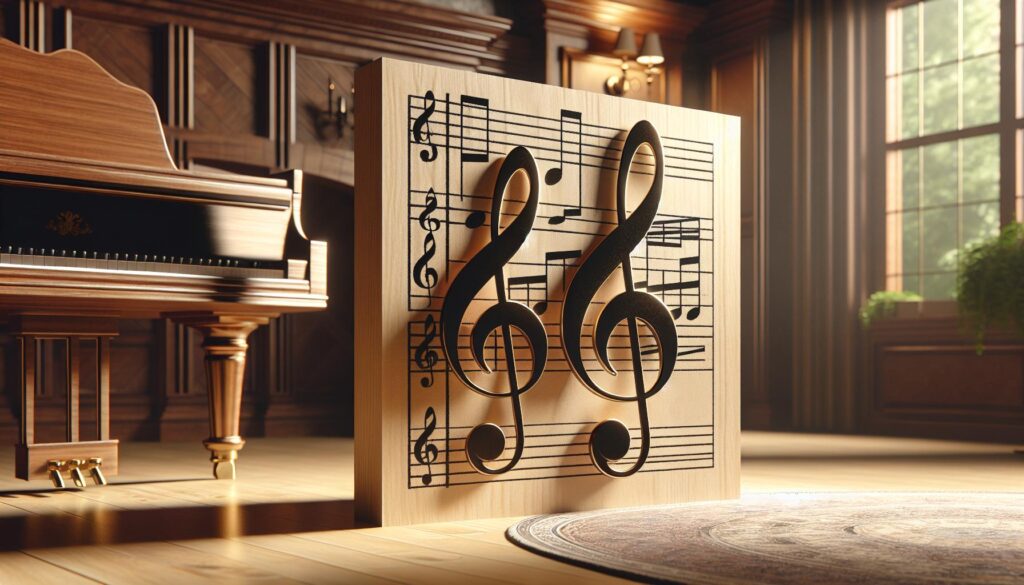When I first started exploring the world of music, I quickly realized how essential the bass clef and treble clef are to understanding notation. These two symbols form the backbone of sheet music, guiding musicians in interpreting pitches and rhythms. Each clef serves a unique purpose, helping to define the range of notes that different instruments and voices can produce.
The bass clef, often associated with lower-pitched instruments like the cello and bassoon, contrasts with the treble clef, which is typically used for higher-pitched instruments such as the violin and flute. Understanding the relationship between these clefs opens up a whole new dimension in music theory and performance. Let’s dive deeper into how these clefs work together to create the rich tapestry of sound we love.
Key Takeaways
- Understanding Clefs: The bass clef and treble clef are fundamental symbols in music notation, each representing distinct pitch ranges essential for reading music accurately.
- Bass Clef vs. Treble Clef: The bass clef, marked as F, is used for lower-pitched instruments (e.g., cello, bassoon), while the treble clef, marked as G, is used for higher-pitched instruments (e.g., violin, flute).
- Interplay Between Clefs: Both clefs can overlap in certain musical contexts, allowing for harmonic arrangements and enriching compositions, especially in keyboard play.
- Visual Identification: The bass clef features a stylized “”F,”” while the treble clef resembles a cursive “”G,”” helping musicians quickly identify their respective ranges.
- Role in Music Theory: Both clefs are vital for understanding music theory, facilitating composers and musicians in creating harmonically rich pieces and clear notations across varying pitch ranges.
- Instrument Associations: Different instruments are categorized by their clef usage—bass clef for lower instruments (e.g., tuba, double bass) and treble clef for higher instruments (e.g., trumpet, clarinet), influencing repertoire selection.
Bass Clef:w06nfkalwgo= Treble Clef
Clefs serve as essential symbols in music notation that designate which pitches are represented on a staff. The two most commonly used clefs are the bass clef and treble clef, each catering to different pitch ranges.
- Bass Clef: The bass clef, also known as the F clef, indicates lower pitches. It marks the fourth line from the bottom of the staff as the note F. Instruments such as the cello, bassoon, and tuba primarily read this clef.
- Treble Clef: The treble clef, commonly referred to as the G clef, signifies higher pitches. It marks the second line from the bottom as the note G. Instruments such as the violin, flute, and trumpet usually utilize this clef.
- Relationship: Understanding the interplay between these two clefs is crucial. The bass clef and treble clef occupy specific ranges, often overlapping in certain contexts, allowing for diverse harmonic arrangements. Musicians frequently use both clefs when playing piano or other keyboard instruments, providing a rich palette for performance and composition.
By grasping the functions and relationships of these clefs, musicians can enhance their reading skills and overall comprehension of music.
Differences Between Bass Clef And Treble Clef
Bass clef and treble clef serve distinct purposes in music notation, each utilizing specific characteristics and applications to indicate pitch ranges. Understanding these differences is crucial for musicians.
Visual Characteristics
Bass clef features a symbol resembling a stylized letter “”F,”” which indicates the placement of the F note on the fourth line of the staff. Treble clef, on the other hand, uses a symbol that resembles a cursive letter “”G,”” marking the G note on the second line of the staff. The contrasting shapes of these clefs help musicians identify which range of notes to read easily.
Notation And Usage
Bass clef primarily notates lower-pitched notes, making it suitable for instruments such as the cello, bassoon, and tuba. Treble clef caters to higher-pitched notes, commonly utilized by instruments like the violin, flute, and trumpet. While bass clef:w06nfkalwgo= treble clef can overlap in certain musical contexts, they guide musicians in performing the appropriate pitches according to their respective ranges. Together, they form a cohesive musical framework essential for multi-instrumental compositions.
Importance In Music Theory
Bass clef and treble clef are vital components in music theory. They serve as fundamental tools for musicians, enhancing performance and comprehension of musical pieces.
Role In Musical Composition
Bass clef and treble clef guide composers in crafting harmonically rich pieces. They enable the arrangement of multiple voices or instruments, ensuring clarity across varied pitch ranges. For instance, when composing for piano, I utilize both clefs to notate harmony and melody, allowing the performer to navigate complex musical structures effortlessly. This dual-clef system fosters creativity while maintaining structural integrity, providing musicians with a clear framework for their expressions.
Understanding Musical Ranges
Understanding the distinct bass clef:w06nfkalwgo= treble clef musical ranges represented by bass clef and treble clef is crucial for effective performance. Bass clef encompasses lower pitches, suitable for instruments like the cello and bassoon, while treble clef covers higher pitches, apt for the violin and flute. Recognizing this separation aids in selecting the right repertoire for specific instruments. Additionally, the overlaps in some compositions allow for experimentation, enriching the overall texture. By mastering these ranges, musicians enhance their interpretative skills and broaden their repertoire choices.
Common Instruments Using Each Clef
Different bass clef:w06nfkalwgo= treble clef are categorized based on their pitch ranges and the clefs used in their notation. Here’s a look at some common instruments associated with the bass clef and treble clef.
Instruments For Bass Clef
- Cello: The cello produces rich, lower tones and primarily reads music in the bass clef, facilitating expressive performances.
- Bassoon: The bassoon’s deep, resonant sound utilizes the bass clef, allowing it to perform harmonically within diverse ensembles.
- Tuba: As a brass instrument, the tuba plays in the bass clef, contributing foundational bass lines in orchestras and bands.
- Double Bass: The double bass, also known as the upright bass, predominantly reads bass clef notation, enhancing the lower register in various music genres.
- Bass Guitar: The bass guitar, used in many modern music styles, typically reads in the bass clef, providing rhythm and harmonic support.
- Violin: The violin, with its higher pitch range, reads music in the treble clef, enabling it to perform melodic lines in orchestras and ensembles.
- Flute: The flute plays primarily in the treble clef, producing bright, soaring melodies that often stand out in compositions.
- Trumpet: The trumpet’s brilliant tone utilizes the treble clef, allowing it to resonate prominently within orchestras and jazz bands.
- Clarinet: The clarinet plays predominately in treble clef, adding versatility to various genres, including classical and jazz.
- Saxophone: The saxophone, especially the alto and soprano versions, commonly uses the treble clef, facilitating its inclusion in melodic and harmony-rich settings.
World Of Musical Possibilities
Mastering the bass clef and treble clef is essential for any musician aiming to enhance their skills. These clefs not only define pitch ranges but also enrich our understanding of music theory. By recognizing the unique characteristics of each clef and their associated instruments, we can improve our reading abilities and performance.
Whether you’re playing the cello or the flute, knowing how to navigate these clefs opens up a world of musical possibilities. It allows for a deeper connection to the music we play and compose. Embracing the interplay between the bass and treble clefs ultimately fosters greater creativity and expression in our musical endeavors.



